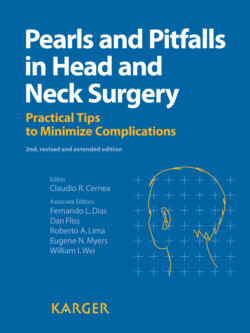Читать книгу Pearls and Pitfalls in Head and Neck Surgery - Группа авторов - Страница 22
На сайте Литреса книга снята с продажи.
ОглавлениеThyroid and Parathyroid Glands
Cernea CR, Dias FL, Fliss D, Lima RA, Myers EN, Wei WI (eds): Pearls and Pitfalls in Head and Neck Surgery. Basel, Karger, 2012, pp 32–33
DOI: 10.1159/000337959
1.16 Management of Invasive Thyroid Cancer
Thomas V. McCaffrey
Department of Otolaryngology, Head and Neck Surgery, University of South Florida, Tampa, Fla., USA
P E A R L S
• Hoarseness, airway obstruction and particularly hemoptysis are signs of upper aerodigestive tract (UADT) invasion by thyroid cancer.
• Laryngeal function can often be preserved by partial laryngectomy procedures even if invasion has occurred.
• Postoperative external beam radiation therapy (EBRT) may control unresectable invasive thyroid cancer (ITC) and preserve laryngeal function.
P I T F A L L S
• Inadequate resection of ITC will result in severe morbidities of airway obstruction, hemoptysis and dysphagia.
• Overestimating the need for radical resection may lead to the loss of salvageable laryngeal function.
Introduction
Well-differentiated carcinoma of the thyroid (WDTC) is a generally curable disease with a mortality rate quoted as between 11 and 17%. When WDTC extends beyond the thyroid capsule and produces invasion of the UADT structures, it is the cause of considerable increased morbidity and increased mortality.
In a review by McConahey et al. [1], cause of death from WDTC was related to untreatable local disease in 36% of cases and metastatic disease in 39% of cases. Control of ITC is therefore an important clinical problem, and it would be expected that successful treatment of ITC would include survival and reduced morbidity. ITC can produce symptoms as a result of paralysis of one or both recurrent laryngeal nerves (LN) resulting in hoarseness or airway obstruction, direct invasion of the trachea or larynx with the potential of airway obstruction and bleeding, invasion of the esophagus resulting in bleeding and dysphagia. Treatment goals for ITC include the prevention of hemorrhage and air obstruction, preservation of the function of the UADT, prevention of local/ regional recurrence, and optimally long-term survival.
Practical Tips
Surgical Techniques
Larynx. Invasion can occur by direct extension and erosion of the laryngeal cartilage or by invasion around the posterior and inferior aspects of the thyroid cartilage into the paraglottic space. Often, it is unilateral, permitting conservative operations (e.g., partial vertical laryngectomy, PVL). If the mucosa is not directly involved, removal of the thyroid cartilage without entering the airway is also possible. LN invasion presents special problems. If paralysis has occurred, LN is resected with the tumor. Rehabilitation by thyroplasty offers an excellent result. However, in some cases, perineural invasion occurs without paraly-sis of the nerve. Although some controversy exists, peeling of tumor from the nerve preserving its function does not appear to result in reduced survival.
Trachea. Invasion may be relatively superficial with erosion or invasion of the cartilage rings without mucosal involvement, or it may be deep with intraluminal extension (IE). When IE occurs, full-thickness resection (FTR) of the trachea is the optimal treatment, occasionally as a window resection if the invasion is localized. The defect can be repaired with a myofacial flap from the sternocleidomastoid or other adjacent muscles. If the invasion is circumferential, tracheal resection is indicated, eventually extended up to include part of the cricoid, if necessary.
Pharynx/Esophagus. Because of the loose submucosal layer, tumor may involve the muscle coat without invasion through the underlying mucosa. This usually permits stripping of the muscle with preservation of the mucosa. If limited mucosal invasion does occur, resection with primary repair is possible. Extensive esophageal invasion may require laryngopharyngectomy and reconstruction with a jejunal or cutaneous free flap.
Shave Resection (SR) versus FTR. Some controversy still remains on the appropriate resection of minimally invasive tumors. Advocates for FTR of the airway state that, although the tumor may appear to be superficially invasive, usually extension into the submucosal plane occurs and that leaving a tumor behind results in higher recurrence rate [2]. Proponents of SR argue that there is no evidence to indicate survival improvement by FTR and that adding postoperative EBRT results in a similar disease-free survival [3]. Presently, the final word is not yet established. Certainly, in elderly patients or those who have other morbidities which may limit their survival, a less invasive, less traumatic procedure may be of benefit. Younger patients, in whom eradication of disease could extend survival, would benefit from more aggressive resections. This still remains an individual surgical decision.
EBRT has become more widely used in treating ITC. There are no controlled trials, although anecdotal results indicate that it may be helpful in selected cases [4].
Conclusion
WDTC invading the UADT and LN causes significant morbidity/mortality. Successful treatment is possible while preserving function. PVL, tracheal resections, SR and EBRT eliminate morbidity, preserve function, reduce local recurrence and may improve survival.
References
1 McConahey WM, Woolner LB, van Heerden JA, Taylor WF: Papillary thyroid cancer treated at the Mayo Clinic, 1946-1970: initial manifestations, pathological findings, therapy, and outcome. Mayo Clin Proc 1986;61:978–996.
2 Grillo HC, Suen HC, Mathisen DJ, Wain JC: Resectional management of thyroid cancer invading the airway. Ann Thorac Surg 1992;54:3–9.
3 Lipton RJ, McCaffrey TV, van Heerden: Surgical treatment of invasion of the upper aerodigestive tract by well-differentiated thyroid carcinoma. Am J Surg 1987;154:363–367.
4 Brierley JD, Tsang RW: External beam radiation therapy in the treatment of differentiated thyroid cancer. Semin Surg Oncol 1999;16:42–49.
Prof. Thomas V. McCaffrey, MD, PhD
Professor and Chair
Department of Otolaryngology,
Head and Neck Surgery
University of South Florida
12902 Magnolia Drive, Suite 3057
Tampa, FL 33612-9497 (USA)
E-Mail Thomas.McCaffrey@Moffitt.org
